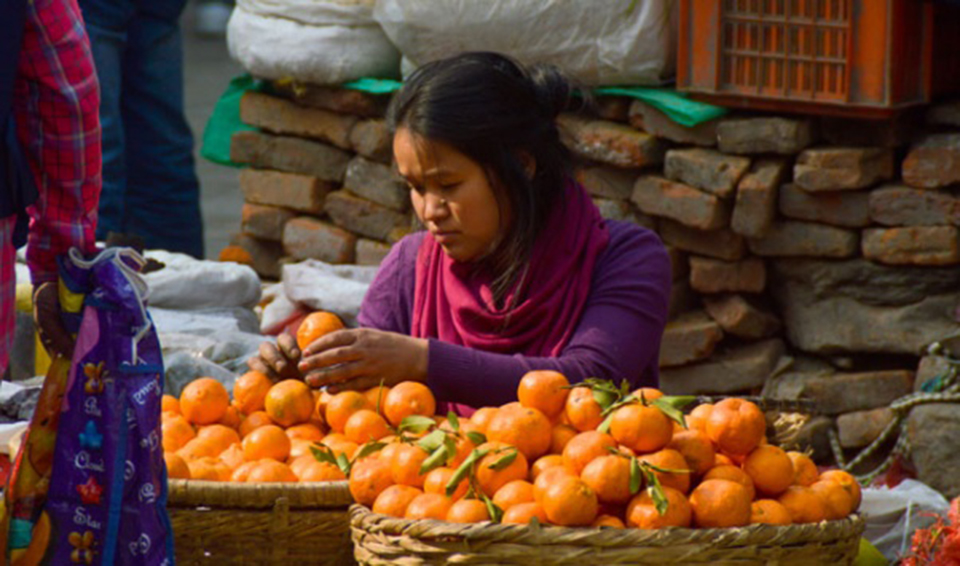
OR
CITRUS FRUITS

Mandarin orange presents great business proposition in mid-hill and over 300 pockets have been developed.
Nepal is home to a great variety of citrus fruits. Many species of this fruit of high commercial value—mandarin orange, sweet orange (particularly Junar), lime, lemon and hill-lemon (Nibuwa)—are found in abundance in this country. Citrus fruits make up around 36 percent of total fruit production and mandarin orange is one of the most important in terms of area coverage, production, consumption and export potential. Though it is grown in more than 50 districts, 39 mid-hill districts have the potential for commercial production. These districts occupy around 65 percent of area of citrus fruit cultivation, contributing around 67 percent to total production.
Mandarin orange now presents a serious business proposition in mid-hill districts and more than 300 pockets have already been developed. Junar, an indigenous variety of sweet orange, is the second most important citrus fruit that is cultivated mainly in Sindhuli, Ramechhap and Dhankuta districts. Acid lime and hill lemon are other major citrus fruits. Rough lemon, pummelo, grapefruit, sour lemon, citron, sweet lime, calamondin and kumquat are also grown on small scales.
Citrus cultivation checks soil erosion and its production is thus sustainable and environment-friendly. That is why government policies and programs aim to focus on orange cultivation in our mid-hills.
Potential aplenty
There is 6.6 percent annual household demand growth for orange. Besides this, the export potential of mandarin oranges to neighboring markets is high. Indian border cities are densely populated and located at short distances. Chinese border markets have also become increasingly accessible. High growth potential of the domestic market and vast scope of cross-border trade with populous India, China and Bangladesh are all promising—provided Nepal can produce quality fruits. People there prefer Nepali oranges.
There is a huge potential of for increasing citrus fruit productivity due to the wide gap between actual and attainable yields. Worldwide, citrus yield ranges from 50 to 90 tons/hectare. It is in rage of 20-30 t/ha in India and Pakistan, two main citrus producing countries of SAARC region. According to National Citrus Development Program (NCDP), citrus fruit yield in Nepal was 8.79 t/ha for 2015/16. This can be increased to 15 t/ha simply by improving orchard management practices such as timely application of required amounts of manure and fertilizers, disease and pest management, tree pruning, mulching, irrigation, etc.
The Fruit Development Directorate (FDD) has reported decreasing production and productivity of citrus fruits. The production figures for 2011 and 2016 were 240793 tons and 218000 tons respectively. Productivity for the same period was 10 t/ha and 8.79 t/ha respectively. This decreasing trend reflects in low supply of oranges in markets.
This is a high season for Nepali oranges. But according to Kalimati Fruits and Vegetables Market Development Board (KFVMDB), orange supply has dropped by 50 percent this year. As a regular consumer of oranges, this author has also noticed this worrying trend. It is not only about supply, quality is also low. Also, wrong-shaped and small-sized oranges are increasingly seen in our markets.
Why is this happening despite several government efforts aimed at citrus development? This is because of distribution of low quality planting material and decline of productive trees.
“Citrus decline” refers to a condition of ill health of citrus trees which may arise from a number of factors—both biotic (diseases and insect-pests) and abiotic (soil, water and nutrition).
Recently, an FAO survey conducted in 128 citrus pockets of 32 districts in Nepal, noted two main factors for declining citrus production in the country: negligence in orchard management and spread of Phytophthora-induced diseases due to intercropping close to tree trunks.
Missing expertise
Nepal has proven technologies to control and minimize these effects. Productivity of mandarin orange with high-quality fruits can be enhanced to about 15-20 ton/ha with these technologies. Trees over 25-30 years old and showing severe decline (more than 50 percent twigs/branch dead, chlorotic and sparse foliage) need to be replaced and disease-free nurseries should be established immediately. We can also use Phytophthora-resistant rootstocks.
Government agencies have already started establishing orchards with quality planting implements. Supply of quality planting materials is a major concern as the subsequent growth of fruit trees and their production, both in terms of quantity and quality, depend on it. Hence there is a need for urgent action to restrict uncontrolled flow of non-descript/non-certified planting materials through internal quarantine.
Likewise, the National Citrus Development Program (NCDP) of NARC needs to be more proactive. We desperately need more citrus experts. Field technicians, nursery owners and farmers also need update knowledge in order to make them more productive. Nepal has such high potential on citrus fruits. It would be a tragedy to miss out.
bhairabr@gmail.com
You May Like This

Leftist poll win has little to do with India, China: Experts
KATHMANDU, Dec 21: As the leftist parties -- CPN-UML and CPN (Maoist Center) -- prepare to form a new government after... Read More...

Little things
Living in an apartment, or in an older home with tiny rooms, can present a challenge bigger than just how... Read More...




Just In
- CM Kandel requests Finance Minister Pun to put Karnali province in priority in upcoming budget
- Australia reduces TR visa age limit and duration as it implements stricter regulations for foreign students
- Govt aims to surpass Rs 10 trillion GDP mark in next five years
- Govt appoints 77 Liaison Officers for mountain climbing management for spring season
- EC decides to permit public vehicles to operate freely on day of by-election
- Fugitive arrested after 26 years
- Indian Potash Ltd secures contract to bring 30,000 tons of urea within 107 days
- CAN adds four players to squad for T20 series against West Indies 'A'















Leave A Comment